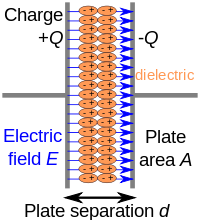
Photo from wikipedia
The advantage of hybridizing battery and supercapacitor electrodes has succeeded recently in designing hybrid charge storage systems such as lithium-ion capacitors (LICs) with the benefits of higher energy than supercapacitors… Click to show full abstract
The advantage of hybridizing battery and supercapacitor electrodes has succeeded recently in designing hybrid charge storage systems such as lithium-ion capacitors (LICs) with the benefits of higher energy than supercapacitors and more power density than batteries. However, sluggish Li-ion diffusion of battery anode is one of the main barriers and hampers the development of high-performance LICs. Herein, is introduced a new conversion/displacement type anode, MnCO3 , via effectively recycling spent Li-ion batteries cathodes for LICs applications. The MnCO3 cuboids are regenerated from the spent LiMn2 O4 cathodes by organic acid lixiviation process, and hydrothermal treatment displays excellent reversibility of 535 mAh g-1 after 50 cycles with a Coulombic efficiency of >99%. Later, LIC is assembled with the regenerated MnCO3 cubes in pre-lithiated form (Mn0 + Li2 CO3 ) as anode and commercial activated carbon (AC) as the cathode, delivering a maximum energy density of 169.4 Wh kg-1 at 25 °C with ultra-long durability of 15,000 cycles. Even at various atmospheres like -5 and 50 °C, this LIC can offer a energy densities of 53.8 and 119.5 Wh kg-1 , respectively. Remarkably, the constructed AC/Mn0 + Li2 CO3 -based LIC exhibits a good cycling performance for a continuous 1000 cycles with >91% retention invariably for all temperature conditions.
Journal Title: Small
Year Published: 2023
Link to full text (if available)
Share on Social Media: Sign Up to like & get
recommendations!